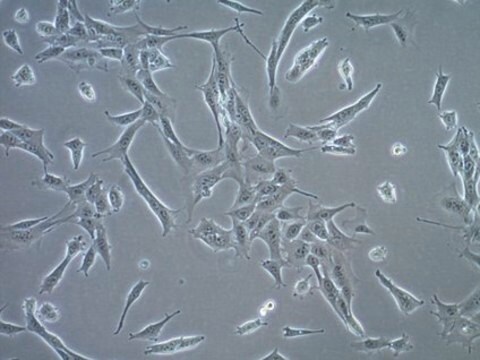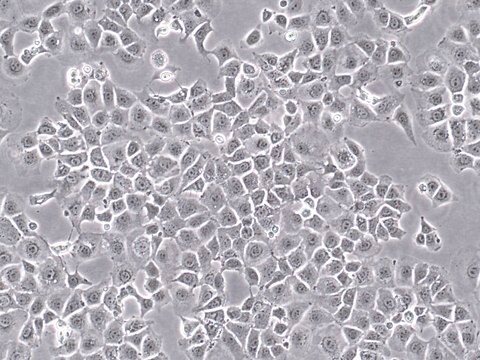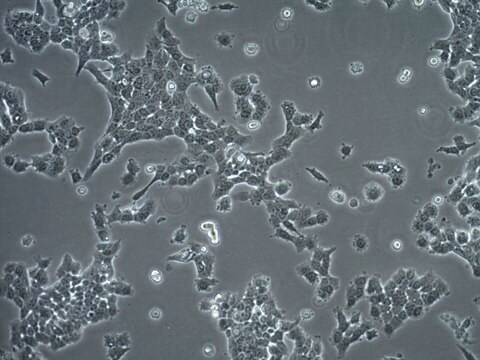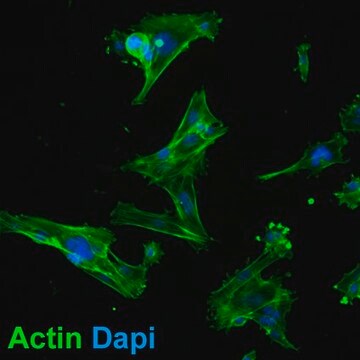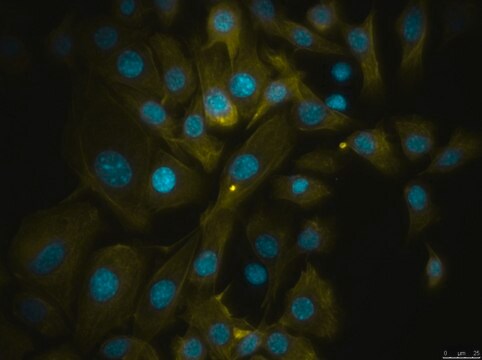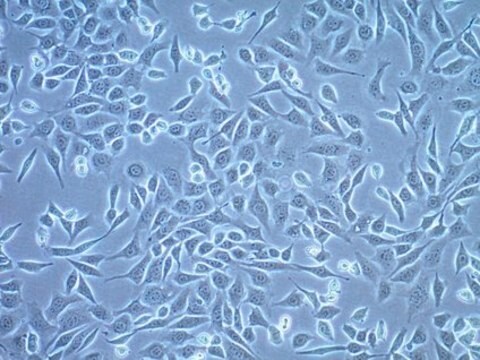SCC178
AT-3 Mouse Mammary Carcinoma Cell Line
Mouse
Sinônimo(s):
Ms mammary gland cells
Faça loginpara ver os preços organizacionais e de contrato
About This Item
Código UNSPSC:
41106514
eCl@ss:
32011203
NACRES:
NA.81
Produtos recomendados
product name
AT-3 Mouse Mammary Carcinoma Cell Line, AT-3 mouse mammary tumor cell line may be used to develop mouse models for mammary cancer studies.
fonte biológica
mouse
técnica(s)
cell culture | mammalian: suitable
Condições de expedição
ambient
Categorias relacionadas
Descrição geral
The AT-3 cell line was isolated from an autologous mammary tumor from cells originating in a transgenic MTAG mouse model . Mammary tumors arising in MTAG mice closely mimic changes observed in human breast carcinomas over the course of disease progression . AT-3 cells are a useful mouse model for studies of tumor physiology that are representative of typical disease states in humans.
Source:
The AT-3 cell line was derived from primary mammary tumor cells of a transgenic MTAG mouse. The MTAG mouse model expresses the polyoma virus middle T antigen under control of the MMTV-LTR promoter .
Note: AT-3 cells demonstrate diverse morphologies in culture.
Source:
The AT-3 cell line was derived from primary mammary tumor cells of a transgenic MTAG mouse. The MTAG mouse model expresses the polyoma virus middle T antigen under control of the MMTV-LTR promoter .
Note: AT-3 cells demonstrate diverse morphologies in culture.
Tumor-induced immunosuppression is a common phenomenon in cancer and an important consideration for cancer immunotherapy. However, most studies on tumor-induced immunosuppression rely on tumor implant models, in which the disease progresses rapidly and usually causes non-physiological host responses that do not recapitulate normal tumor development and progression . Models that generate autochthonous tumors are therefore valuable for providing more physiologically-relevant systems for investigating tumor-host interactions and longer-term immunosuppressive effects.
Descrição de linhagem celular
Cancer Cells
Aplicação
AT-3 mouse mammary tumor cell line may be used to develop mouse models for mammary cancer studies.
Research Category
Cancer
Oncology
Cancer
Oncology
This product is sold solely for research use per the terms of the “Restricted Use Agreement” which govern its use as detailed in the product Data Sheet or Certificate of Analysis. For information regarding any other use, please contact licensing@emdmillipore.com.
Qualidade
• Each vial contains ≥ 1X10⁶ viable cells.
• Cells are tested negative for infectious diseases by a Mouse Essential CLEAR panel by Charles River Animal Diagnostic Services.
• Cells are verified to be of mouse origin and negative for inter-species contamination from rat, chinese hamster, Golden Syrian hamster, human and non-human primate (NHP) as assessed by a Contamination CLEAR panel by Charles River Animal Diagnostic Services.
• Cells are negative for mycoplasma contamination
• Cells are tested negative for infectious diseases by a Mouse Essential CLEAR panel by Charles River Animal Diagnostic Services.
• Cells are verified to be of mouse origin and negative for inter-species contamination from rat, chinese hamster, Golden Syrian hamster, human and non-human primate (NHP) as assessed by a Contamination CLEAR panel by Charles River Animal Diagnostic Services.
• Cells are negative for mycoplasma contamination
Armazenamento e estabilidade
Store in liquid nitrogen. The cells can be cultured for at least 10 passages after initial thawing without significantly affecting the cell marker expression and functionality.
Exoneração de responsabilidade
This product contains genetically modified organisms (GMO). Within the EU GMOs are regulated by Directives 2001/18/EC and 2009/41/EC of the European Parliament and of the Council and their national implementation in the member States respectively. This legislation obliges {HCompany} to request certain information about you and the establishment where the GMOs are being handled. Click here for Enduser Declaration (EUD) Form.
Unless otherwise stated in our catalog or other company documentation accompanying the product(s), our products are intended for research use only and are not to be used for any other purpose, which includes but is not limited to, unauthorized commercial uses, in vitro diagnostic uses, ex vivo or in vivo therapeutic uses or any type of consumption or application to humans or animals.
Unless otherwise stated in our catalog or other company documentation accompanying the product(s), our products are intended for research use only and are not to be used for any other purpose, which includes but is not limited to, unauthorized commercial uses, in vitro diagnostic uses, ex vivo or in vivo therapeutic uses or any type of consumption or application to humans or animals.
Código de classe de armazenamento
10 - Combustible liquids
Classe de risco de água (WGK)
WGK 2
Certificados de análise (COA)
Busque Certificados de análise (COA) digitando o Número do Lote do produto. Os números de lote e remessa podem ser encontrados no rótulo de um produto após a palavra “Lot” ou “Batch”.
Já possui este produto?
Encontre a documentação dos produtos que você adquiriu recentemente na biblioteca de documentos.
Florian Wiede et al.
Cancer discovery, 12(3), 752-773 (2021-11-20)
Immunotherapies aimed at alleviating the inhibitory constraints on T cells have revolutionized cancer management. To date, these have focused on the blockade of cell-surface checkpoints such as PD-1. Herein we identify protein tyrosine phosphatase 1B (PTP1B) as an intracellular checkpoint
C Patrick Reynolds et al.
Methods in molecular medicine, 111, 335-350 (2005-05-25)
Rodent models provide an important means of assessing antitumor activity vs toxicity for new cancer therapies. Tumors are often grown subcutaneously on the flank or back of animals, allowing accurate serial determination of tumor volume with calipers by measuring the
Trina J Stewart et al.
Journal of immunology (Baltimore, Md. : 1950), 179(5), 2851-2859 (2007-08-22)
Ag-specific and generalized forms of immunosuppression have been documented in animal tumor models. However, much of our knowledge on tumor-induced immunosuppression was acquired using tumor implant models, which do not reiterate the protracted nature of host-tumor interactions. Therefore, a transgenic
C T Guy et al.
Molecular and cellular biology, 12(3), 954-961 (1992-03-01)
The effect of mammary gland-specific expression of the polyomavirus middle T antigen was examined by establishing lines of transgenic mice that carry the middle T oncogene under the transcriptional control of the mouse mammary tumor virus promoter/enhancer. By contrast to
Nossa equipe de cientistas tem experiência em todas as áreas de pesquisa, incluindo Life Sciences, ciência de materiais, síntese química, cromatografia, química analítica e muitas outras.
Entre em contato com a assistência técnica